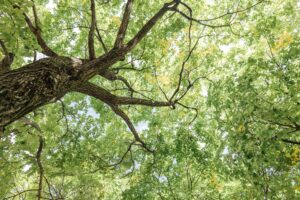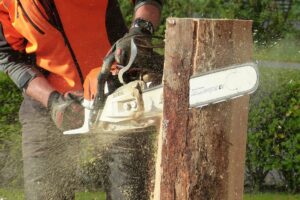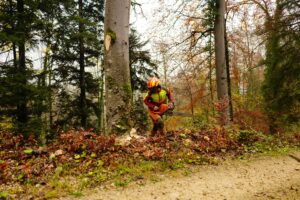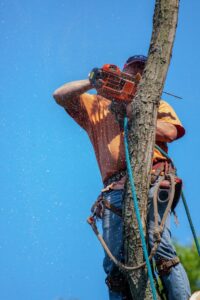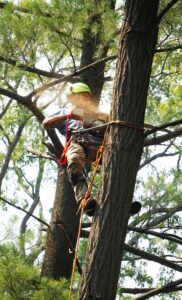Tree Services
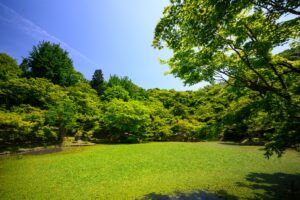
Tree Services
Tree services refer to a range of services related to the care and maintenance of trees. These services can include tree planting, pruning, shaping, cabling and bracing, fertilization, pest and disease management, and tree removal. Tree planting is the process of planting a new tree in a specific location. This can be done for various reasons, such as replacing a tree that has been removed, adding shade or beauty to a property, or improving the environment. Pruning is the process of removing dead, diseased, or damaged branches from a tree. This can be done for various reasons, such as to improve the tree’s overall health, remove branches that are interfering with power lines or buildings, or rove the tree’s appearance. Shaping is the process of trimming and pruning a tree to give it a specific shape. This can be done for aesthetic reasons or to improve the tree’s overall health. Cabling and bracing is the process of providing support to a tree by installing cables and/or braces. This can be done to help support a tree that is at risk of falling over, or to help support a tree that has been damaged by severe weather.
Fertilization is the process of providing nutrients to a tree to help it grow and thrive. This can be done to improve a tree’s overall health or to help a tree recover from damage or disease. Pest and disease management is the process of identifying and treating pests and diseases that are affecting a tree. This can be done to improve a tree’s overall health or to prevent the spread of pests or diseases to other trees. Tree removal is the process of cutting down and removing a tree from a property. This can be done for a variety of reasons, such as to remove a tree that is dead or dying, to remove a tree that is causing damage or danger, or to clear land for development.
It’s important to note that tree services should be performed by licensed, trained professionals to avoid any damage to the tree or property, and also to ensure safety.
Tree services refer to a variety of services related to the care and maintenance of trees. These services can include tree pruning, tree removal, tree planting, stump grinding, and more. Tree services are typically provided by professional arborists, who are trained and certified in the proper care and maintenance of trees. Some tree services also include landscaping services, such as lawn care and garden maintenance.
Tree services refer to the various tasks and activities related to the care and maintenance of trees. Some examples of tree services include:
• Tree trimming and pruning: This involves removing dead or diseased branches, as well as shaping and shaping the tree to promote healthy growth and prevent potential hazards.
• Tree removal: This involves cutting down and removing a tree that is dead, diseased, or poses a danger to property or people.
• Stump grinding: This is the process of removing a tree stump by grinding it down to below ground level using a specialized machine.
• Planting and transplanting: This includes planting new trees, as well as transplanting existing trees to different locations.
• Tree health care: This includes diagnosing and treating diseases, pests, and other issues that may be impacting the health of a tree.
• Emergency tree services: This includes providing services for trees that have fallen or are in danger of falling due to severe weather or other reasons.
These are some examples of tree services, but there may be others that are specific to certain regions or industries.
Process of Tree Service
The process of tree service typically includes the following steps:
1. Inspection: A tree service professional will first inspect the tree(s) in question to assess their condition and determine the appropriate course of action.
2. Pruning: Pruning involves removing dead, diseased, or damaged branches to promote the overall health and safety of the tree.
3. Removal: In some cases, it may be necessary to remove a tree entirely. This can be due to disease, damage, or the tree being in a dangerous location.
4. Stump Grinding: After the tree is removed, the stump is often ground down to prevent regrowth and make the area safe for walking or mowing.
5. Planting: Tree Service professional can also plant a new tree to replace the removed one.
6. Cleanup: After the work is completed, the tree service professional will clean up the area, removing any debris and leaving your property looking neat and tidy.
Government agencies are responsible for managing and maintaining public lands and resources, including trees. This can include planting and maintaining trees in public parks and forests, as well as regulating tree cutting and removal on public lands. Tree services, on the other hand, are typically private companies that provide services such as tree pruning, removal, and planting on private property. Some government agencies may also provide tree services to the public, such as removing hazardous trees from public rights-of-way. All companies should be insured and bonded. For example, if you have an unsightly or dead tree that you need to move make sure that when the job is finished that the company will take away every piece of the tree or trees and that the removal has been done efficiently and safely.
Importance of Tree Services with government
Tree services are important for several reasons:
1. Safety: Trees that are overgrown or damaged can pose a danger to people and property. Tree trimming and removal can help ensure the safety of individuals and buildings.
2. Aesthetics: Tree pruning and shaping can enhance the appearance of a property and increase curb appeal.
3. Health: Trees that are not properly maintained can become diseased or infested with pests, which can cause them to die or become unstable. Tree services can help maintain the health of trees and prevent the spread of disease to other trees.
4. Utility: Tree services can help maintain the utility of trees, such as by preventing damage to power lines, or ensuring the growth of trees in a way that they don’t interfere with buildings or other structures.
5. Environmental benefit: Trees provide many environmental benefits, such as absorbing carbon dioxide, improving air quality, and providing habitats for wildlife. Proper tree care can help ensure that these benefits are maximized.
A knowledgeable tree service company will also be happy to give a potential client free estimates of what they are going to do and the cost for each service along with other information pertinent to the estimate. You should make sure that you get at least two estimates and compare them before making your final decision. One thing that the homeowner should make sure is in the estimate is that they will do a total cleanup along with the removal of any debris from the job. Many reputable tree service companies will also take the time to discuss with the homeowner any landscape goals they have. They will be able to show the homeowner which trees in your yard that could hinder other grasses or plant growths in the area. If the tree service company has looked your trees over and spots any diseases they will tell you about them so you can have them treated so the trees will not die.
Tree services encompass a wide range of activities related to the care and maintenance of trees. Some of the most common services include:
• Tree pruning: This involves removing dead, diseased, or damaged branches from a tree to promote healthy growth and improve the tree’s appearance. Pruning can also be used to shape a tree or to reduce its size.
• Tree removal: This service involves cutting down a tree that is dead, dying, or posing a safety hazard. Tree removal can be a complex and dangerous task, and should only be performed by trained professionals.
• Tree planting: This service involves planting new trees in a landscape. Arborists can help choose the right tree species for a specific location and provide guidance on proper planting techniques.
• Stump grinding: This service involves using a specialized machine to grind down the remains of a tree trunk after it has been cut down. This can be done to remove an unsightly stump or to prepare the area for landscaping or construction.
• Tree fertilization: This service involves applying fertilizer to a tree to promote healthy growth. Arborists can determine the appropriate fertilizer and application method for a specific tree species.
• Tree disease management: This service involves diagnosing and treating diseases that affect trees. Arborists are trained to identify common tree diseases and use appropriate methods to control or eradicate them.
• Tree cabling and bracing: This service involves installing support systems to help strengthen a tree that is at risk of failure due to structural weakness or damage.
• Tree risk assessment: This service involves evaluating the potential risks posed by a tree, such as the likelihood of failure or the potential for damage to property or people.
Overall, tree services help to ensure the health, safety, and beauty of trees in the urban and rural landscape, providing benefits to both the tree, the local ecosystem, and the community.
About Salt Lake City, Utah
Salt Lake City is the capital and most populous city of Utah, United States. It is the seat of Salt Lake County, the most populous county in Utah. With a population of 200,133 in 2020, the city is the core of the Salt Lake City metropolitan area, which had a population of 1,257,936 at the 2020 census. Salt Lake City is further situated within a larger metropolis known as the Salt Lake City–Ogden–Provo Combined Statistical Area, a corridor of contiguous urban and suburban development stretched along a 120-mile (190 km) segment of the Wasatch Front, comprising a population of 2,746,164, making it the 22nd largest in the nation. It is also the central core of the larger of only two major urban areas located within the Great Basin.
Neighborhoods in Salt Lake City, Utah
Poplar Grove, The Avenues, Marmalade, Central City, Fairpark, Ballpark, Downtown, Capitol Hill, Woodbury, Neighborhood House, Rio Grande, The Neighborhood Hive, Rose Park Neighborhood Center, Neighborhood Services, Salt Lake City Community Development, University Neighborhood Partners, Airport East Business Park, Granary Row, Neighborhood Auto Service, Salt Lake City
Things To Do in Salt Lake City, Utah
Bus Stops in Salt Lake City, Utah to Truco Services, Inc.
Bus Stop in Greyhound: Bus Station Salt Lake City, Utah to Truco Services, Inc.
Bus Stop in Salt Lake Central Salt Lake City, Utah to Truco Services, Inc.
Bus Stop in Greyhound: Bus Stop Salt Lake City, Utah to Truco Services, Inc.
Bus Stop in Stadium Station (EB) Salt Lake City, Utah to Truco Services, Inc.
Bus Stop in South Salt Lake City Station Salt Lake City, Utah to Truco Services, Inc.
Bus Stop in 2100 S / 700 E (WB) Salt Lake City, Utah to Truco Services, Inc.
Bus Stop in Salt Lake Central Station (Bay A) Salt Lake City, Utah to Truco Services, Inc.
Bus Stop in 200 S / 1000 E (EB) Salt Lake City, Utah to Truco Services, Inc.
Bus Stop in South Salt Lake City Station Salt Lake City, Utah to Truco Services, Inc.
Bus Stop in 900 E / Wilson Ave (SB) Salt Lake City, Utah to Truco Services, Inc.
Bus Stop in Us Hwy 89 @ 270 S (N. Salt Lake) Salt Lake City, Utah to Truco Services, Inc.
Bus Stop in Courthouse Station Salt Lake City, Utah to Truco Services, Inc.
Driving Directions in Salt Lake City, Utah to Truco Services, Inc.
Driving Directions from Hidden Oak Tree Care to 4640 Commerce Dr, Murray, UT 84107, USA
Driving Directions from A Swedin Tree Expert to 4640 Commerce Dr, Murray, UT 84107, USA
Driving Directions from Atlas Tree Service to 4640 Commerce Dr, Murray, UT 84107, USA
Driving Directions from Diamond Tree Experts to 4640 Commerce Dr, Murray, UT 84107, USA
Driving Directions from Arbor+ to 4640 Commerce Dr, Murray, UT 84107, USA
Driving Directions from Integrated Tree Professionals to 4640 Commerce Dr, Murray, UT 84107, USA
Driving Directions from Urban Oaks Tree Service to 4640 Commerce Dr, Murray, UT 84107, USA
Driving Directions from Greenlite Tree Care to 4640 Commerce Dr, Murray, UT 84107, USA
Driving Directions from Heritage Tree Experts to 4640 Commerce Dr, Murray, UT 84107, USA
Driving Directions from Arborcare-Arborscape, Inc. to 4640 Commerce Dr, Murray, UT 84107, USA
Driving Directions from Arbornauts Tree Experts to 4640 Commerce Dr, Murray, UT 84107, USA
Driving Directions from Amen Trees to 4640 Commerce Dr, Murray, UT 84107, USA
Reviews for Truco Services, Inc. Salt Lake City, Utah
Marissa Burton
TruCo is a great company to work with for your commercial landscaping and snow removal needs! Rob is excellent to work with. He is very timely in providing quotes and has a lot of great feedback and suggestions to provide on what will look great, fit within your budget, and is knowledgeable on plants that will thrive with Utah's ever changing weather conditions. I have been impressed with TruCo's landscape maintenance as well as landscape projects which have had a quick turnaround time. I would highly recommend using TruCo!
Yvonne Olson
I experienced excellent all around service from landscape improvement design, scheduling and professional installation completed within the timeline we discussed. Rob, the manager does an excellent job of communicating, overseeing the install crew and making sure his customers are 100% satisfied with the job. Highly recommend TruCo for all landscaping needs.
Raymond Ferraro
Michael the tree guy is so smart. He knows all about tree removal, cutting and tree trimming services. Truco did amazing work for me. We had 16 very old and mature trees removed. The Truco team showed up on time ready to get the job done. They did amazing with clean up truly respect your property and your life. Communication was really good. They needed to move some things to get the stump grinder to our yard they put things back with no issues. Extremely professional and truly know what they're doing. If anyone is looking for professional tree removal or tree service you really should call Jason or Michael at Truco.
Heather Whiting
We hired TruCo to do a new install of sprinklers, sod, spigot, and bury downspouts. We even have a wifi transmitter for our control box we can access from an app on our phones! We absolutely love the professionalism and quality of their work!! Our sales rep Pete was the best to work with, we highly recommend him to anyone in the market for landscaping. It was awesome seeing the finished results and we're incredibly excited to enjoy our new space!
Jan Merideth
TruCo installed all of our plants, trees and shrubs, drip lines, and boulders. Then they installed our amazing beautiful firepit. We loved the results and they guarantee all plants and trees up to a year. They were great and easy to work with. They listened to our needs and wants and met them 100%. Our HOA sent us a letter telling us they appreciate all the work and the way our yard looks and let us know we added value to the property. Win/Win
